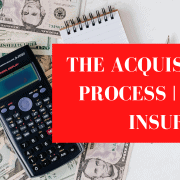Quick Thoughts on Evaluating Real Estate Investments Without Opening Excel
In our industry (commercial real estate), the ability to quickly evaluate investment opportunities is crucial for staying competitive. I know I’ve found in my professional career, that having a clear framework for evaluating – and then either passing or spending more time on – investments is crucial to managing an efficient pipeline. Thus, being able to quickly evaluate CRE investments, especially without the need for a detailed financial model, is often the difference between hitting annual targets or not.
In this summary post, we share ideas from an episode of the A.CRE Audio Series season two where we discuss how to quickly evaluate real estate opportunities without opening Excel.
Note: This article is based on insights from an episode of the A.CRE Audio Series, which you can listen to or watch by clicking here.
I. Understanding the Market and Investment Criteria
The first step to evaluating CRE investments quickly involves understanding the market and having a clear definition of your investment criteria, commonly known as your ‘investment box’. This strategic framework is necessary for filtering opportunities and aligning them with your investment goals. It includes several key components:
Property Types
Know the property types you are interested in. This could range from office buildings and industrial sites to retail spaces or multifamily units. Each type of property has unique characteristics, market dynamics, and investment potentials. For example, office spaces in urban centers may offer different returns and risks compared to industrial properties in suburban areas.
Geographic Focus
Second, define the geographic regions where you intend to invest. This could be as broad as a country or as specific as a neighborhood within a city. Different regions have varying economic drivers, real estate demand, and regulatory landscapes, all of which can significantly impact your investment outcomes. For instance, investing in a rapidly growing city might offer higher growth potential but could also come with increased competition and higher prices.
Market Conditions
In addition, make sure you understand the current market conditions in your chosen location. This includes factors like average occupancy rates, rental yields, property price trends, and economic indicators such as employment rates and GDP growth.
Investment Goals
Clearly articulate your investment goals. Are you seeking short-term gains through value-add strategies, or are you more interested in long-term appreciation and steady cash flow? Your goals will dictate the types of properties and projects you consider, influencing everything from risk tolerance to capital allocation.
Risk Assessment
Every investment carries risk, and understanding these risks is integral to your investment box. Assess factors such as market volatility, tenant stability, and economic downturns. Identifying potential risks associated with different property types and locations can help you make informed decisions and prepare mitigation strategies.
Capital and Resources
Finally, evaluate the capital availability and the resources at your disposal. This includes not only the financial aspects but also the human resources needed to manage the properties effectively. Knowing your budgetary limits and operational capabilities can help refine your search for feasible investments.
Through these components, you can establish a well-defined investment box and more efficiently sift through numerous opportunities. This will not only streamline the evaluation process but also enhance the likelihood of successful investment outcomes.
II. Key Metrics and Techniques for Quick Analysis of CRE Investments
When evaluating CRE investments, essential metrics like cap rates, net operating income (NOI), and yield on cost are critical. These metrics offer a high-level view of an investment’s potential performance and can be quickly calculated without the need for complex models. Understanding and applying these metrics allows you to efficiently gauge the financial health and expected returns of a property.
To further streamline the evaluation process, employ simple back-of-the-envelope calculations. Techniques such as comparing the yield on cost to the market cap rate quickly provide a comparative snapshot of potential returns against current market conditions. This method can enable you to assess whether a property is likely to perform above or below market averages and facilitating quicker investment decisions.
III. Developing Intuitive Assessment Skills
Seasoned professionals in commercial real estate should develop an intuitive sense of quickly evaluating investments through extensive experience. The foundation for this intuitive sense is a comprehensive understanding of market conditions and fundamental metrics. Over time, you will be able to almost instinctively gauge the viability of a project based on initial data points, without needing to dive into spreadsheets for every calculation.
Additionally, employing rules of thumb for specific markets or property types significantly speeds up the evaluation process. These rules of thumb are practical generalizations made from historical data and market trends, such as typical leasing costs, average vacancy rates, and expected stabilization expenses for different kinds of properties. For instance, knowing that a certain type of office space in a specific city typically achieves a certain occupancy rate or rental price per square foot can indicate whether your projected performance aligns with market norms.
IV. Learning from Experienced Professionals
Finally, engaging with experienced professionals is invaluable for both new and seasoned investors. Gaining insights into the rules of thumb used by veteran investors can reduce the learning curve and enhance your ability to evaluate potential deals quickly. Learning from those who have navigated multiple market cycles can give you a nuanced understanding of how various factors influence property values and investment returns.
Mentorship and networking with seasoned professionals offer practical, real-world insights that are often not covered in textbooks or formal education. Moreover, engaging with industry veterans will give you access to a broader network of contacts, including potential partners, clients, and financial resources. It also opens the door to co-investment opportunities and collaborations that might not be available through traditional channels.
Conclusion
To improve your skills in evaluating CRE investments quickly, it’s crucial to understand your market, use simplified financial metrics effectively, and learn from experienced professionals. This approach allows for rapid, informed decision-making that can give you an edge in a competitive market.
Frequently Asked Questions about Quickly Evaluating Real Estate Investments Without Excel
What is an “investment box” and why is it important?
An “investment box” refers to a predefined set of investment criteria—such as property types, geographic focus, market conditions, goals, risk tolerance, and capital constraints—used to filter opportunities. “Having a clear definition of your investment criteria… is crucial to managing an efficient pipeline.”
Which property metrics can be evaluated without Excel?
Cap rate, net operating income (NOI), and yield on cost are key metrics that “can be quickly calculated without the need for complex models,” enabling fast assessment of a property’s financial performance.
How can yield on cost help in quick investment analysis?
Yield on cost helps estimate return relative to investment and can be compared to the market cap rate. “Comparing the yield on cost to the market cap rate quickly provides a comparative snapshot of potential returns.”
Why is intuitive assessment valuable in CRE?
With experience, professionals can “instinctively gauge the viability of a project based on initial data points,” making it possible to act decisively without always relying on models.
What role do rules of thumb play in fast CRE evaluations?
Rules of thumb allow for quick assessments using practical generalizations. “These rules… such as typical leasing costs or vacancy rates, significantly speed up the evaluation process.”
How can market understanding aid quick decision-making?
Knowing the “economic drivers, real estate demand, and regulatory landscapes” of a region helps quickly determine whether an investment aligns with strategic goals.
What are the benefits of learning from seasoned professionals?
Mentorship provides “real-world insights that are often not covered in textbooks,” helping investors learn faster and improve decision-making through shared experience.
What’s the main takeaway for evaluating investments without Excel?
Build a clear investment box, know your key metrics, develop intuition through practice, and “learn from experienced professionals” to make faster, smarter investment decisions without always needing a model.










